Introduction
Both local origin and organic production methods are potential value-added attributes that ornamental plant growers and retailers can use to promote their products. Some consumers are willing to pay (WTP) premiums (up to 10% more) for organic or local plants (Hawkins et al. 2012). However, implementing, maintaining, and promoting local and/or organic products require substantial economic and labor inputs. Therefore, it is important to know consumer perceptions toward these attributes to decrease grower and retailer risks before producing and offering these products.
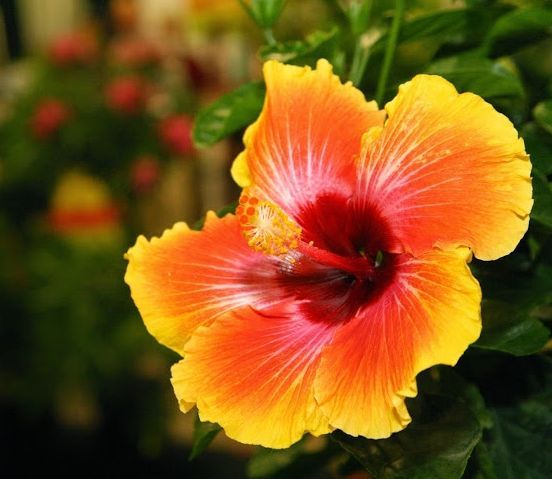
Previous studies on local and organic food products show consumers value local and organic attributes (Yiridoe et al. 2005). Studies investigating consumer preferences for these traits in ornamental plants, however, are less common and often provide conflicting results. Occasionally, local origin is viewed as more important than organic production (Yue et al. 2011), while other times organic production is perceived as being more important than local origin (Hawkins et al. 2012; Schimmenti et al. 2013). Studies suggest that consumers value local and organic ornamental plants, but the level of importance that they assign to these features varies across geographical locations, making it important to study consumer groups by location. For instance, plants with local origins were perceived as more important than those produced using organic production methods for Minnesota, Indiana, Michigan, and Texas consumers (Yue et al. 2011). However, Maine consumers preferred organic plants to locally grown plants (Hawkins et al. 2012).
Variances in consumer preferences for organic and local plant attributes may be related to confusion about what the attributes mean. A recent investigation of consumer preferences in the United States and Canada showed that almost one out of five people confused "local" and "organic" attributes (Campbell et al. 2014). In order to sell their products as organic, growers must meet United States Department of Agriculture (USDA) criteria. Specifically, the National Organic Program indicates that in order for a product to be labeled as "certified organic," it must be grown using methods to protect natural resources, conserve biodiversity, and use only approved substances (USDA/AMS 2013). Prohibited substances include irradiation, sewage sludge, synthetic fertilizers, prohibited pesticides, and genetically modified organisms (USDA/AMS 2013). The USDA/ERS (2014) defines local food systems as "farmers selling directly to consumers." Furthermore, the 2008 Food, Conservation, and Energy Act states that the total transported distance must be less than 400 miles from origin to point-of-sale or within the state of production for the product to be considered "local" (Harris et al. 2008).
In this document, we define local and organic ornamental plants from the perspective of Floridian consumers. We also compare the two attributes in terms of plant-purchasing behavior and interest. Knowing consumer preferences reduces grower and retailer risk when determining production and promotional strategies. A better understanding of consumer preferences by growers and retailers also serves as an important feedback loop and benefits consumers through increased access to plants with desirable traits.
Definitions
Local Ornamental Plants
In June/July 2014, approximately 300 plant consumers in central Florida were asked to define "local" by distance and proximity to their residences. Most consumers (>50%) perceive local ornamental plants to be grown within 19 miles of where they are sold (Figure 1). A fair number of consumers (36–47%) view local plants as grown within 20–59 miles of where they are sold, while fewer consumers (<27%) define local plants as being grown more than 60 miles from where they are sold.

Regarding proximity to consumers' residences, the majority of the respondents perceive local plants as those grown within their county of residence and neighboring counties (70%), within 10 miles of their residence (59%), or solely within their county of residence (58%) (Figure 2). Approximately 43% of consumers view plants grown within their state of residence as local. However, 96% perceive Fresh from Florida plants as local (Figure 3). There are several factors that may contribute to this difference. First, Florida is one of the leading states in ornamental plant production (USDA/NASS 2007). Consequently, Floridian consumers may consider ornamental plants grown within the state as local. Additionally, familiarity with the Fresh from Florida campaign may have positively influenced their perspectives. Of the respondents, 83% indicated that they had noted Fresh from Florida on plants before the study. The differences in perceptions of "state of residence" and Fresh from Florida indicate that broader in-state origin designation promotions are associated less with local origins.
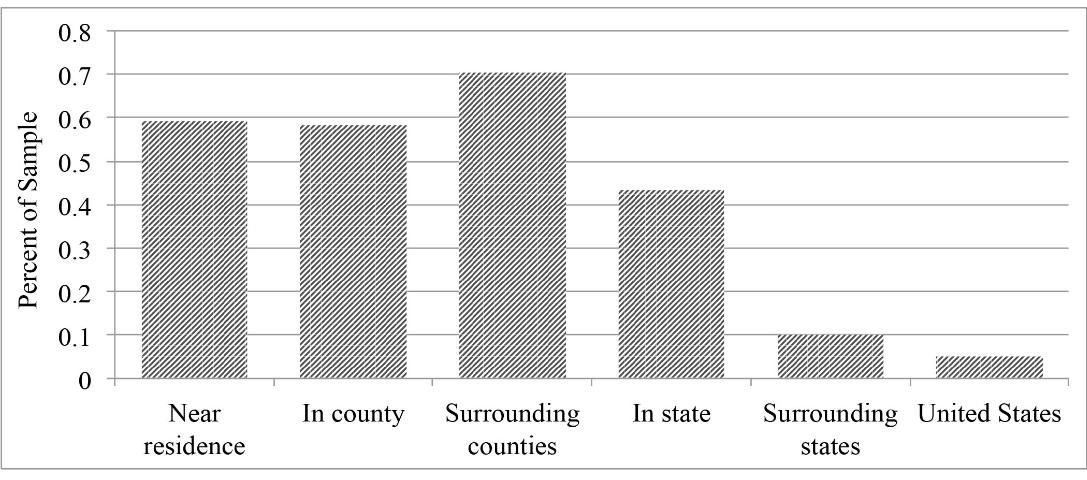

Figures 4 and 5 provide a snapshot of the benefits consumers associate with local ornamental plants. The surveyed consumers agree that the most important benefits are those related to improving the local economy (jobs/money), product safety, product quality, and reduced pollution.
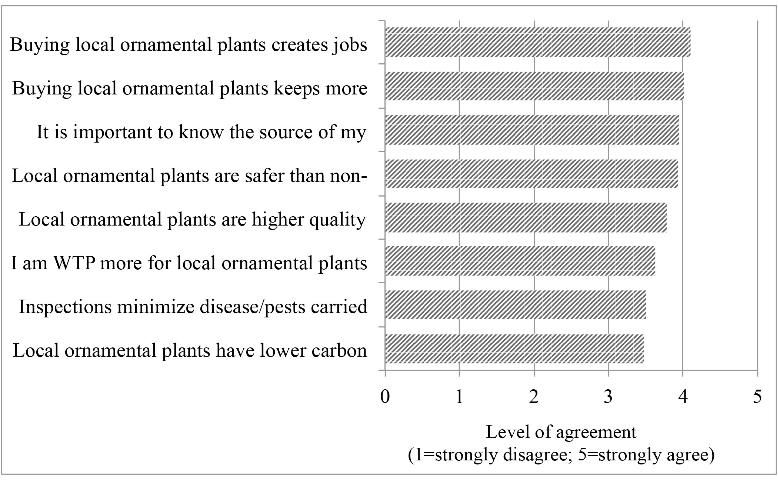
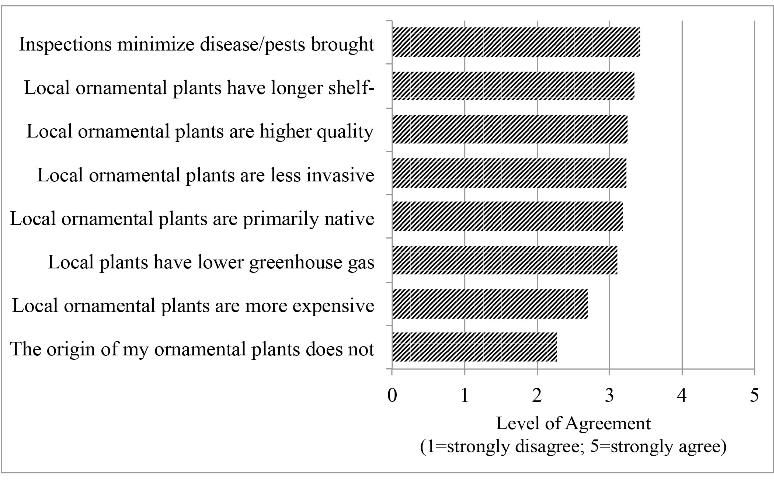
Organic Ornamental Plants
Central Floridian plant consumers were also asked to define "organic" plants. Over 70% of the surveyed consumers believe organic plants use natural fertilizers and pesticides and are more environmentally friendly than conventionally produced plants (Figure 6). About 60–70% view organic plants as pesticide free, not genetically modified, healthier, more expensive, and safer for children compared to conventional plants. Approximately 50–59% perceive organic plants as having less pesticide residue, lower toxicity, more compost use, and better soil structure, as well as being safer for pets, and more pollinator friendly, than conventional plants. In addition, 40–49% associate organic plants with integrated pest management, decreased pollution (smaller carbon footprint and reduced greenhouse gasses), and the use of non-synthetic fertilizers (Figure 7). Fewer of these Floridians (<40%) identify organic ornamental plants with synthetic additives (fertilizers/pesticides) and decreased transportation distance (transportation, local).
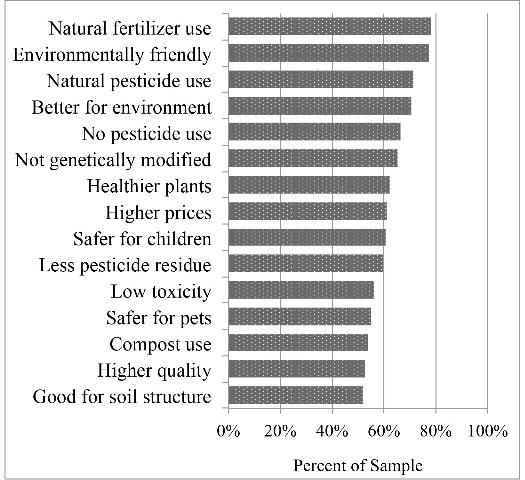
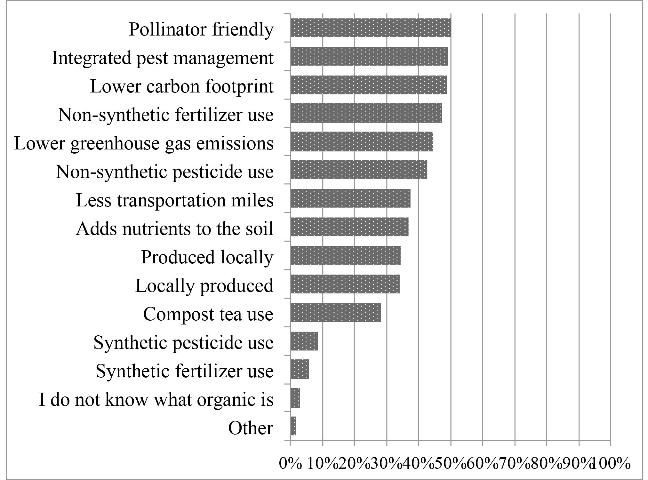
When compared to the National Organic Program (NOP) standards (USDA/AMS 2013), consumer perceptions are fairly accurate with regards to natural fertilizers/pesticides, environmental health, genetically modified organisms, and compost usage (Figure 5). One area where consumer perceptions were inaccurate was "no pesticides used;" in fact, organic producers can use non-synthetic pesticides provided they are on the NOP list of allowed substances. Many of the attributes selected by participants highlight their perceptions of organic (i.e., healthier, higher priced, safer for children/pets, low toxicity, higher quality) rather than the NOP standards. These perceptions are consistent with previous research (Campbell et al. 2014) and provide points of differentiation for retailers and growers. Approximately 35% of the participants wrongly connected organic production to local origins (as indicated by the percent of participants who selected less transportation miles and produced locally). This percentage is slightly higher than previous research (Campbell et al. 2014). The NOP standards do not include a maximum distance traveled or origin requirement.
Local Versus Organic
Regarding purchasing frequency, 40% of Floridian consumers frequently purchase local ornamental plants (Figure 8). Conversely, only 8% frequently purchase organic ornamental plants. In fact, 57% state they rarely or never purchase organic ornamental plants. Similarly, their purchasing decisions are more likely to be impacted by local (Fresh from Florida) plants than organic plants (Figure 9). Often the benefits associated with organic production are improved personal or environmental health, which consumers may perceive as not applying to ornamental plants (Yue et al. 2011). In contrast, local product benefits often include higher quality, local economy support (assuming that the relative cost of local production is lower compared to that of non-local economies), product availability, and suitability for local environment. Conversely, local plants are more prevalent in Florida since it is a primary production state (USDA/NASS 2007). Consumer perceptions of benefits and product availability likely impact the frequency of purchasing local and organic plants.

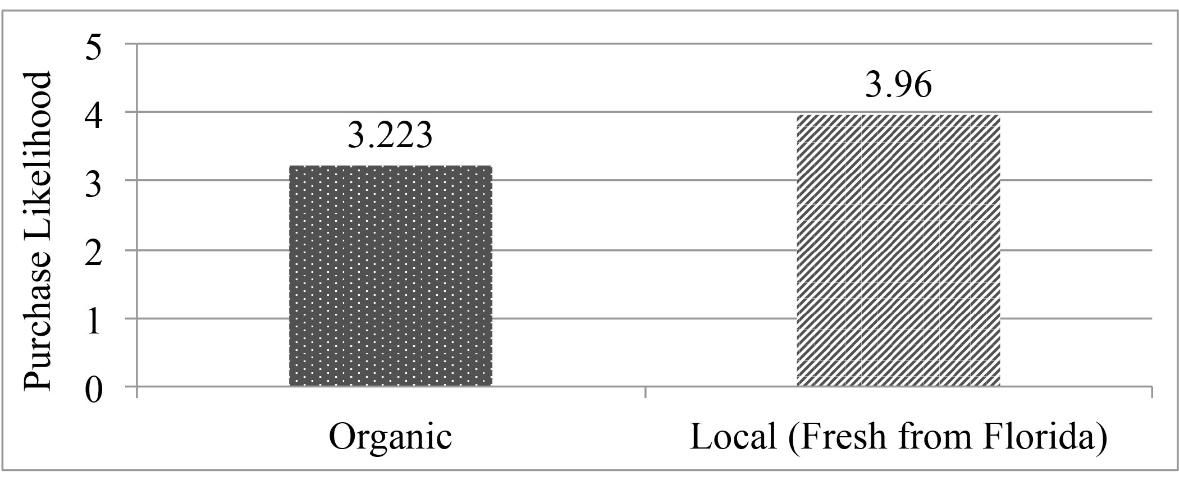
Since perceived benefits of local and organic plant attributes differ, the importance that consumers assign to these attributes may vary by the type of plant. Overall, consumer interest is greater for local plants than for organic plants (Figure 10); however, some interesting trends are evident if one considers different types of plants. While consumers are interested in all types of plants produced locally (as indicated by greater ratings), they exhibit the most interest in local perennials, vegetables, herbs, flowering annuals, and ornamental plants that are better acclimated to the local environmental conditions. Consumers are also interested in local seeds, shrubs and trees. They are least interested in local houseplants (flowering or foliage). Floridian consumers are more interested in organic edible plants (vegetable and herb plants), and less interested in organic non-edible plants. This is not surprising because edible plants can directly impact human health.
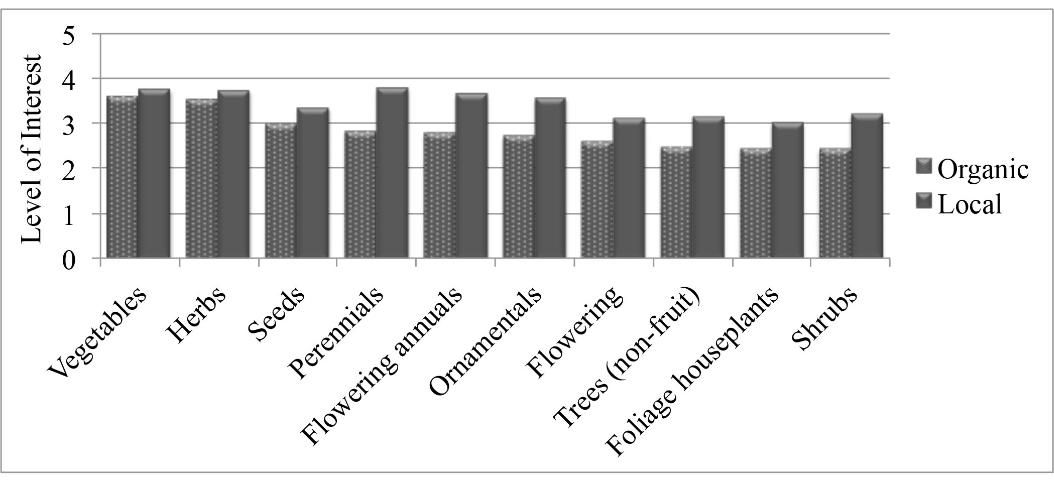
Summary
Horticultural consumers in Florida are interested in local and organically produced plants. They define local as plants that are grown near where they are sold. They identify the most important local benefits as product safety and quality, as well as community support. Organic plants are perceived as requiring fewer chemical additives (fertilizer/pesticides) and being healthier for the environment. The importance of these traits varies by plant type.
Overall, our results suggest that growers could benefit from growing and promoting local ornamental plants and organic edible plants. Garden center retailers could benefit through promoting the origins of local plants. Retailers specializing in edible plants could benefit through promoting the health benefits of organic plants. In addition, all potential benefits depend on the cost of local or organic production/being less than that of alternative production methods.
It is important to note that the cost of sourcing plants locally or from organic producers needs to be considered by growers, wholesalers, and retailers when contemplating producing and carrying products with these attributes. Additionally, the premium that consumers are willing to pay for local and/or organic plants impacts the profitability of offering these products. Sourcing costs and WTP premiums were not discussed in this report but suggest an interesting direction for future research.
References
Campbell, B., H. Khachatryan, B.K. Behe, J.H. Dennis, and C.R. Hall. 2014. US and Canadian consumer perceptions of local and organic terminology. International Food and Agribusiness Management Review 17:21-40.
Harris, W., B. Lubben, J. Novak, and L. Sanders. 2008. The Food, Conservation, and Energy Act of 2008 summary and consequences. Extension National Farm Bill Train the Trainer Conference, Kansas City, MO.
Hawkins, G., S.E. Burnett, and L.B. Stack. 2012. Survey of consumer interest in organic, sustainable, and local container-grown plants in Maine. HortTechnology 22:817-825.
Schimmenti, E., A. Galati, V. Borsellino, C. Ievoli, C. Lupi, and S. tinervia. 2013. Behaviour of consumers of conventional and organic flowers and ornamental plants in Italy. Horticultural Science 40:162-171.
USDA/AMS. 2014. National Organic Program website. United States Department of Agriculture, Agricultural Marketing Service (USDA/AMS), Washington, D.C. http://www.ams.usda.gov/AMSv1.0/nop.
USDA/ERS. 2014. Local Foods. United States Department of Agriculture, Economic Research Service (USDA/ERS), Washington, D.C. http://www.ers.usda.gov/topics/food-markets-prices/local-foods.aspx.
USDA/NASS. 2007. 2007 Census of Agriculture—Greenhouse, Nursery, and Floriculture Operations. United States Department of Agriculture, National Agricultural Statistics Service (USDA/NASS), Washington, D.C.
Yiridoe, E.K., S. Bonti-Ankomah, and R.C. Martin. 2005. Comparison of consumer perceptions and preference toward organic versus conventionally produced foods: A review and update of the literature. Renewable Agriculture and Food Systems 20:193-205.
Yue, C., J.H. Dennis, B.K. Behe, C.R. Hall, B. Campbell, and R.G. Lopez. 2011. Investigating consumer preference for organic, local, or sustainable plants. HortScience 46:610-615.